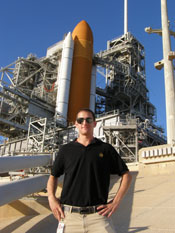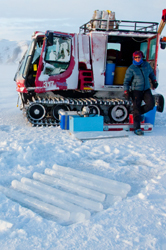|
Fall 2011
Letters Home...
 David Smith is a fourth year graduate student in Biology and Astrobiology. As part of the Hands-On Project Experience (HOPE) 2012 Training Opportunity for NASA Personnel, David combines his graduate education with practical, on-the-job training at the Kennedy Space Center, outside Orlando, Florida, where he spends at least one quarter each academic year. This year, David spent the last three months leading a team of scientists and engineers to develop a near-space mission to use high-altitude balloons for sampling Microorganisms in the Stratosphere (MIST). In the coming months, MIST balloons will be launched into the Earth's upper atmosphere to take samples that will allow David, his team, and follow NASA scientists to comprehensively characterize airborne microbiology in our own stratosphere. David Smith is a fourth year graduate student in Biology and Astrobiology. As part of the Hands-On Project Experience (HOPE) 2012 Training Opportunity for NASA Personnel, David combines his graduate education with practical, on-the-job training at the Kennedy Space Center, outside Orlando, Florida, where he spends at least one quarter each academic year. This year, David spent the last three months leading a team of scientists and engineers to develop a near-space mission to use high-altitude balloons for sampling Microorganisms in the Stratosphere (MIST). In the coming months, MIST balloons will be launched into the Earth's upper atmosphere to take samples that will allow David, his team, and follow NASA scientists to comprehensively characterize airborne microbiology in our own stratosphere.
Working at the Kennedy Space Center offers more than the usual field experience, though. As a Principal Investigator (P.I.) on a NASA mission, David is partnering with and learning from highly talented teams in astrobiology research and has an up-close view of the many projects housed at "our nation's gateway to exploring, discovering, and understanding the universe." We recently heard from David on the eve of a major rocket launch and, just as you would expect, he is finding himself at the center of exciting, nail-biting developments in astrobiology.
David writes...
From my laboratory here at Kennedy Space Center, I have an unobstructed view of Launch Complex-41 where the Curiosity Rover, equipped with the new Mars Science Laboratory (MSL), sits atop a massive United Launch Alliance Atlas V rocket awaiting liftoff on Saturday November 26, weather permitting. The excitement is palpable -- on par with any human spaceflight mission I have experienced since starting work at NASA in 2007.
Though thousands of visiting scientists and tourists might say differently, it seems to me that the intensity surrounding this launch actually has little to do with the exploration or any discoveries that await the rover on Mars. There is even more at stake than that.
Kennedy Space Center has been in the business of launching rockets for over half a century, achieving an extraordinary and unparalleled success rate. Following the last Space Shuttle flight in July, amidst thousands of layoffs, a tanking economy and fuzzy vision for NASA's future, the past several months have been filled with a sense that it might all be coming to an end soon. Nevertheless, in this environment, this mission and MSL provide a timely opportunity to demonstrate what Kennedy Space Center does best: launch vehicles off the planet. The recent failure of Russia's $200 million, Mars-bound Phobos-Grunt mission three weeks before the MSL's scheduled launch is a painful reminder of how very difficult this task remains.
Nevertheless, on the Saturday morning after Thanksgiving, the spotlight will turn to Florida, where the United States has a bigger and more ambitious Mars spacecraft waiting on the pad. It will take about six months after launch for the MSL science to begin, but one celebration should start this weekend.... Because, when the Atlas V engines light and Curiosity takes aim for the Red Planet, Kennedy Space Center will remind the world at this critical juncture that it is an irreplaceable resource for reliable access to space.
Return to Front Page
Photo: David Smith in front of the launch pad a Kennedy Space Center in Orlando, Florida. Courtesy of David Smith.
Letters Home...
 Jeff Bowman is a biological oceanography graduate student, studying with Professor Jody Deming in Oceanography and Astrobiology. Since oceans cover a vast majority of Earth's surface, Jeff and his fellow oceanographers have a lot of potential field sites to choose from when looking for somewhere to conduct research. But for astrobiologists, who are searching for an understanding of the different ways and environments in which life can evolve, you have to work in environments that can be extreme. In Jeff's case, the extreme is cold. Really, really cold. Jeff Bowman is a biological oceanography graduate student, studying with Professor Jody Deming in Oceanography and Astrobiology. Since oceans cover a vast majority of Earth's surface, Jeff and his fellow oceanographers have a lot of potential field sites to choose from when looking for somewhere to conduct research. But for astrobiologists, who are searching for an understanding of the different ways and environments in which life can evolve, you have to work in environments that can be extreme. In Jeff's case, the extreme is cold. Really, really cold.
Jeff, along with Shelly Carpenter, Manager of Professor Deming's lab in the School of Oceanography, spent the past two months on an NSF-funded trip to Antarctica studying the environment and life-cycle of algae that grow in and on sea ice -- one of the most inhospitable, almost extraterrestrial environments on the planet. Jeff chronicled his and Shelly's work in an outstanding blog and we caught up with him right before they started out on the long journey back from McMurdo Sound to Puget Sound. As we learned, even the best prepared scientist is likely to encounter some unexpected (and potentially overpowering) experiences in the field.
Jeff writes...
 We should have expected the smell. We should have expected the smell.
Over the last two months Shelly Carpenter and I had been sampling sea ice cores from McMurdo Sound, a deep ice-covered bay adjacent to our research base at McMurdo Station, Antarctica. Sea ice is a topic of study in astrobiology because it is an excellent analogue for the many frozen environments in our solar system and beyond. Our samples were taken during the transition from winter to spring conditions in the Sound, a time when the sea ice ecosystem changes quickly and dramatically.
In the spring and summer sunlight supports the growth of a dense community of photosynthetic algae within and directly underneath the ice. Anchoring to the sea ice ensures algae access to light, but that doesn't mean that it's an easy place to live. Antarctic sea ice starts to thicken in the early fall but doesn't reach its maximum thickness until early summer. Because of this, algae growing on the underside of sea ice are continually exposed to harsh conditions imposed by ice growth. To protect themselves these algae produce copious amounts of a mucous-like substance and a variety of small molecules to help buffer the environment in and around an algal cell. Among the most common of these molecules is a sulfur compound called DMSP, which in addition to helping algae survive is an important food source for bacteria, the focus of our study. Unfortunately, when they consume DMSP, bacteria produce a variety of sulfur-containing compounds that easily vaporize and produce the unmistakable smells most of us would associate with a seaweed-covered beach, natural hot spring, or a tidal mudflat.
Unusually thin ice over the past couple months resulted in a number of large cracks that persisted in spite of the cold temperatures, which forced us to relying on a helicopter to transport us to and from our sampling site. Now, with a helicopter the hour-long drive was reduced to a 15 minute flight, but it also meant a long wait for transport after we finished sampling.
Meanwhile, the ice algae were so thick in our final set of ice cores that they formed a brown mat at the bottom of each core, similar to what you might find on the surface of a stagnant pond. By the time we got the cores back to the lab at McMurdo Station, the samples had spent quiet a while in their airtight containers and a significant quantity of smelly sulfur compounds had leached from the ice cores. In microbiology one gets used to not being able to see what you study. Without a microscope one could never see the bacteria responsible, but in some instances you don't need to see something to know it's there. The smell on opening the sample containers only two hours after sampling was enough to momentarily chase me out of the room!
Return to Front Page
Photos: (Upper Left) Jeff Bowman collects ice core samples in Anarctica. (Lower Right) Shelley Carpenter with core samples collected in September. Courtesy of Jeff Bowman & Shelly Carpenter.
|

 David Smith is a fourth year graduate student in Biology and Astrobiology. As part of the
David Smith is a fourth year graduate student in Biology and Astrobiology. As part of the 
 We should have expected the smell.
We should have expected the smell. 